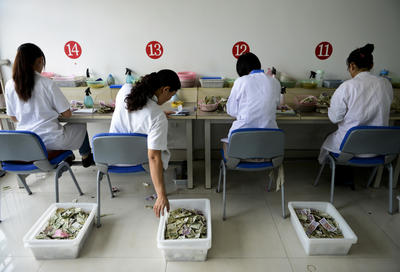To understand China’s current account imbalances, first one must understand what drove savings up.
A popular explanation of the rise in Chinese savings is that high household income insecurity fuels high saving rates. But this explanation alone is silent about corporate and government savings, which contribute much more significantly to overall saving rates. In the past decade corporate savings rose as profits rose and wages declined. And government savings rose as the revenue dividend from higher growth was poured into public capital formation.
Private consumption as a share of China’s GDP declined from 50 per cent to 33 per cent between 1990 and 2010, fuelling the popular myth about the role of household saving. But China’s private consumption has grown at a strong pace of 8 per cent to 9 per cent per annum over the past 20 years. The penetration of colour televisions, refrigerators, washing machines and air-conditioners has increased tenfold.
These realities of China’s consumption are hidden by the overall growth of China’s economy, which grows even faster than consumer demand. GDP grew more than 10 per cent annually between 1990 and 2010. Gross capital formation increased at a breakneck speed of 15 per cent a year over these two decades. Importantly for the current account balance, this rising investment was more than fully financed by even faster rising savings. China’s gross national savings rose from less than 40 per cent of GDP in 1990, to 53 per cent by 2010.
The factors behind China’s high saving rate are multiple, but the principal causes can be roughly aggregated into two sets of interacting and reinforcing forces. The first set consists of the following structural forces in the domestic Chinese economy. Surplus rural labour allowed rapid industrialisation paced by capital-widening investment and provided migrants willing to work at the going wage. A predictable result of such a large-scale transfer of labour at a relatively stable wage is a falling labour share of output and a parallel rise in profits and the saving rate. The rising working-age population and the collapse of the commune system together had also added to this trend.
The other set of factors encompasses institutional changes that took place in the 1990s and 2000s. These include labour downsizing at state-owned companies, reform of the pension system and the introduction of private home ownership.
Employment at state-owned companies, which until then had provided much social welfare and security, almost halved between 1995 and 2005. This restructuring enhanced firms’ efficiency and profitability while presenting workers with increased job insecurity and expenditure uncertainty. At the same time, pension reforms reduced pensions and increased contributions to government pension schemes. The introduction of private home ownership in the 1990s boosted household planning for home purchases and increased the government’s land revenue in a high-growth environment. All these changes increased the saving rates in the government, corporate and household sectors.
Future trends in these structural forces and institutional evolution suggest that China’s aggregate saving rate over the coming years could plateau and then ease off noticeably from its current level of more than 50 per cent of GDP, dramatically affecting the current account. Three structural factors stand out: state-enterprise restructuring, demographic change and continued urbanisation.
First, large-scale corporate restructuring and labour retrenchment in China are mostly over. The scope for big, one-off cost savings and efficiency gains in the corporate sector is limited, as will be the associated income and expenditure uncertainties for Chinese households. Less restructuring and insecurity will dampen private saving by both firms and households.
Second, China’s working-age population could actually stop growing altogether in 2015 and then shrink for 10 years or more. This could lead to a declining household saving rate and a slower pace of corporate investment spending, likely resulting in lower potential output growth unless productivity growth rises in an offsetting manner. Rapid population ageing may also place added burden on fiscal expenditure, trimming government saving.
Third, there are signs that China has reached the ‘Lewis turning point’ at which the modern economy has absorbed most surplus farmers. Industrial wages will then need to rise to attract further migrants into industry. Wages can then rise faster than productivity, raising labour’s share of income and depressing corporate saving. In this context personal consumption can displace investment. Recent reports of double-digit wage growth make this conjecture plausible.
During this process, government policy can play a role in assisting the desired transition to a more balanced growth model in several ways. Further deregulation to reduce entry barriers in labour-intensive services is the most important policy, because this would create more jobs and thereby support the demand for labour and wage growth. A stronger but sustainable social safety net would also help, as would stronger incentives for government provision of public and social services.
Changing structural forces and sensible policy initiatives will rebalance the Chinese economy. The current account surplus could narrow from 3 per cent of GDP in 2011 toward 1 per cent over the coming decade. While this would require both private and public consumption spending to do more to drive economic growth, investment may remain a leading growth engine.
Guonan Ma is Senior Economist at the Bank for International Settlements, Hong Kong.
Lillie Lam is Senior Economist at the Bank for International Settlements, Hong Kong.
Robert McCauley is Senior Advisor for the Monetary and Economic Department of the Bank for International Settlements, Switzerland.
Guonan Ma, Robert McCauley and Lillie Lam’s research was presented at China Update 2012. The annual China Update conference is hosted by the China Economy Program in collaboration with the East Asia Forum at the ANU in July. This article is a digest of Ma, McCauley and Lam’s chapter in Huw McKay and Ligang Song (eds), Rebalancing and Sustaining Growth in China (ANU E Press, 2012), available in pdf here. This book is the latest publication in the China Update Book Series, launched at the China Update conference every year.

